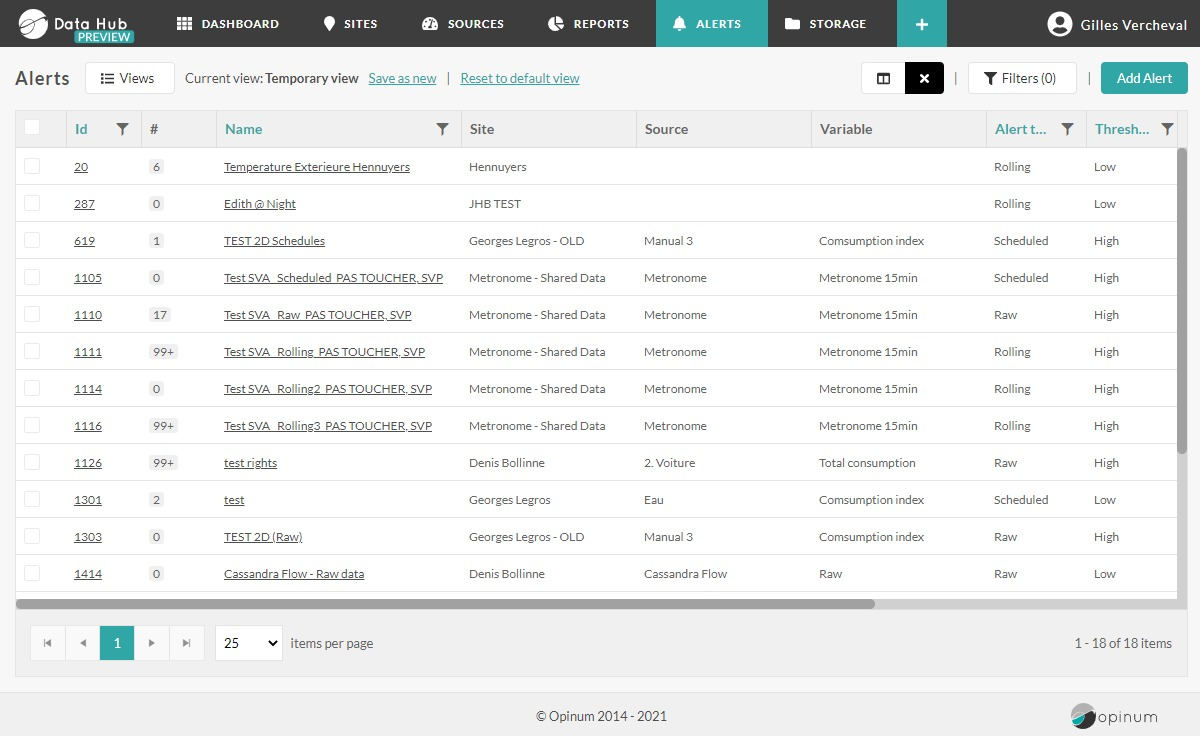Manage alerts
Alerts are displayed and can be managed in the Alerts page in Opinum Data Hub. You can customize the information displayed on this page, and save it as views. A view is a set of alerts saved as you sorted, filtered and displayed them.
Important
Alerts will be decommissioned this year, in favor of alarms, which are more efficient and offer greater functionality.
Learn more about alarms.

Customize Alerts page display
Every users will see all the alerts created on the account.
Choose columns
The following information can be displayed in the Alerts table:
- Name
- ID
- Number of alerts fired (#)
- Site
- Source
- Variable
- Alert types
- Threshold
- Value
- Frequency
- Granularity
- Status
- Next execution date
- Created by
- Created date
- Updated by
- Updated date
To choose columns to be displayed, click on the Actions menu > click on Choose columns. The Table columns filter pop-up opens, just select the columns you want to display.
Sort columns
Data can be sorted with a click on the header of the following columns:
- Name
- ID
- Alert types
- Threshold
- Value
- Status
- Frequency
- Granularity
- Next execution date
- Created by
- Created date
- Updated by
- Updated date
Filter columns
Data can be filtered with a click on the wheel icon of each column.
Advanced search
At the top of the page, you can search alerts with a custom filter query syntax.
Note
Learn more about the syntax to use.
Reset display
You can reset the display of the page in the Actions menu:
- Clear all filters: reset the Sources page in initial set up, without any views, sorting and filtering.
- Reset columns setting: display the columns in initial set up, with the initial width and order.
Monitor alerts
Number of alerts fired is displayed in the # column.
Alerts can be activated or deactivated by the switch in the Status column.
Use alerts views
Create views
Set up of the columns, sorting and filtering can be saved in a View by clicking on the Save View button.
Each view of a user must have a unique name.
Share views within the account
A view can be shared within an account by activating the switch in the Save view pop-up that can be opened with the Save button or the Edit icon.
A shared view will be displayed in the Views drop-down of all the users of the account, in Read only mode (except for the creator fo the view). All the users will be able to create reports and dashboards based on this shared view, and will see all the sources of the view in the report.
When a report or a dashboard use a public view, this view can’t be delete or un-shared within the account.
Note
The use of views of sources in alerts and calculated variables is not available yet.
Manage views
Actions you can do on each view are available in the Views drop-down, at the top left of the page.
- Edit the name of the view and (un)shared the view within the account.
- Duplicate the view.
- Delete the view. If the view is shared within the account and used in a report or a dashboard by another user it can't be deleted.
Bulk actions
From this Alerts page you can run several bulk actions on several sources or in the Actions menu, or by selecting at least 2 sources.
Duplicate alerts
Select the alerts you want to duplicate. The bottom menu will appear, click on the Duplicate button.
Delete alerts
Select the alerts you want to delete. The bottom menu will appear, click on the Delete button.
Warning
When an alert is deleted, all the history of the alert will be deleted as well. The data can't be retrieved.
